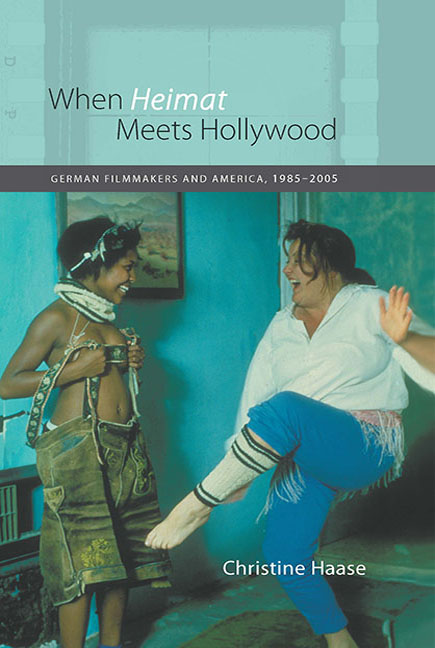Book contents
- Frontmatter
- Dedication
- Contents
- Acknowledgments
- Introduction
- 1 German and American Film Relations in the Twentieth Century
- 2 Wolfgang Petersen: Blockbuster Auteur?
- 3 “Foil, Toothpaste, ID4”: Ideology and Global Appeal in the Films of Roland Emmerich
- 4 Crossing Boundaries, Connecting People: The German-American Films of Percy Adlon
- 5 “Bambi, Zombie, Gandhi”: The Cinema of Tom Tykwer
- Conclusion
- Works Cited
- Index
1 - German and American Film Relations in the Twentieth Century
Published online by Cambridge University Press: 11 May 2017
- Frontmatter
- Dedication
- Contents
- Acknowledgments
- Introduction
- 1 German and American Film Relations in the Twentieth Century
- 2 Wolfgang Petersen: Blockbuster Auteur?
- 3 “Foil, Toothpaste, ID4”: Ideology and Global Appeal in the Films of Roland Emmerich
- 4 Crossing Boundaries, Connecting People: The German-American Films of Percy Adlon
- 5 “Bambi, Zombie, Gandhi”: The Cinema of Tom Tykwer
- Conclusion
- Works Cited
- Index
Summary
The connections between German and American cinema reach back to the beginnings of the industry. Early political, economic, and cultural dynamics prefigure in various ways the competition and collaboration between American and German film throughout the twentieth century. To situate and contextualize the analyses of the directors discussed in this study, their approaches toward filmmaking, and their works, this chapter will provide an introductory outline of the complex history of film in Germany in view of its Hollywood influences and interrelations. The objective here is not to produce a streamlined and unified version of this bi-national narrative into which the directors can then easily and seamlessly be integrated. Quite the contrary: the goal is to analyze trends and developments frequently marked by difference and contradiction that have long characterized German-American film relations, even though the story told until recently has often been one of constant one-way U.S. influence, domination, and “cultural imperialism.”
In the spirit of probing that story, the following chapter aims to complicate facile categorizations and assessments, while at the same time offering a referential analysis of ways of engagement with Hollywood that relate to the four directors’ methods, be they emulative, appropriating, or oppositional.
Great Expectations: The Early Years 1895–1918
As soon as film began to take shape at the end of the nineteenth century, American and German inventors and media pioneers played an important part in the technological and creative development of the cinema and its popularity with paying audiences. Many of these developments occurred in transatlantic connection with each other, some simultaneously, some in quick succession. American photographer Eadweard Muybridge, in one of many examples, invented the “Zoopraxiscope” during the 1870s, while German photographer Ottomar Anschütz invented the Schnellseher (his take on the Zoetrope), the “Tachyskop,” and its successor the “Elektrotachyskop” during the 1880s, all devices that simulate movement through the use of multiple still photographs. During the 1890s, Thomas Alva Edison experimented with cinematographic images in the United States, built the first film studio in 1892, a structure known as the “Black Maria,” and launched the “Kinetoscope” in 1894, the first moving picture apparatus offered for sale.
- Type
- Chapter
- Information
- When Heimat Meets HollywoodGerman Filmmakers and America, 1985–2005, pp. 14 - 62Publisher: Boydell & BrewerPrint publication year: 2007

